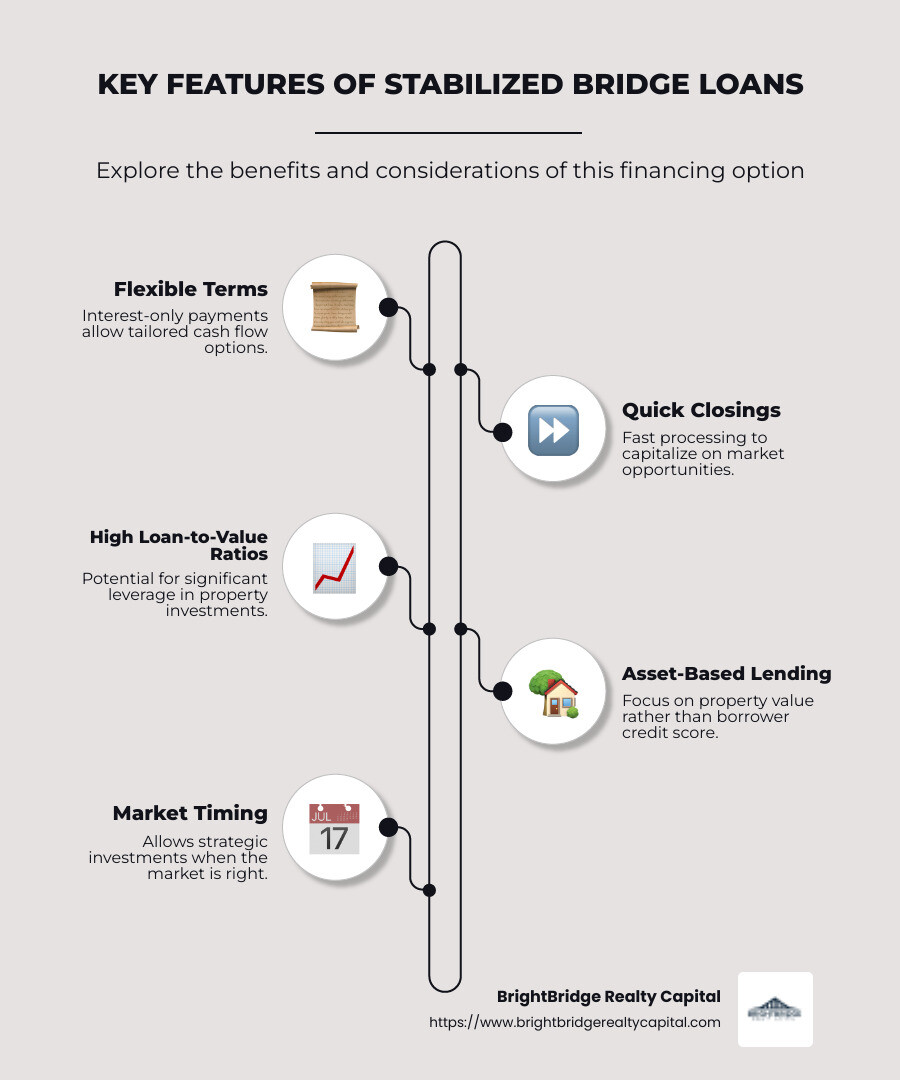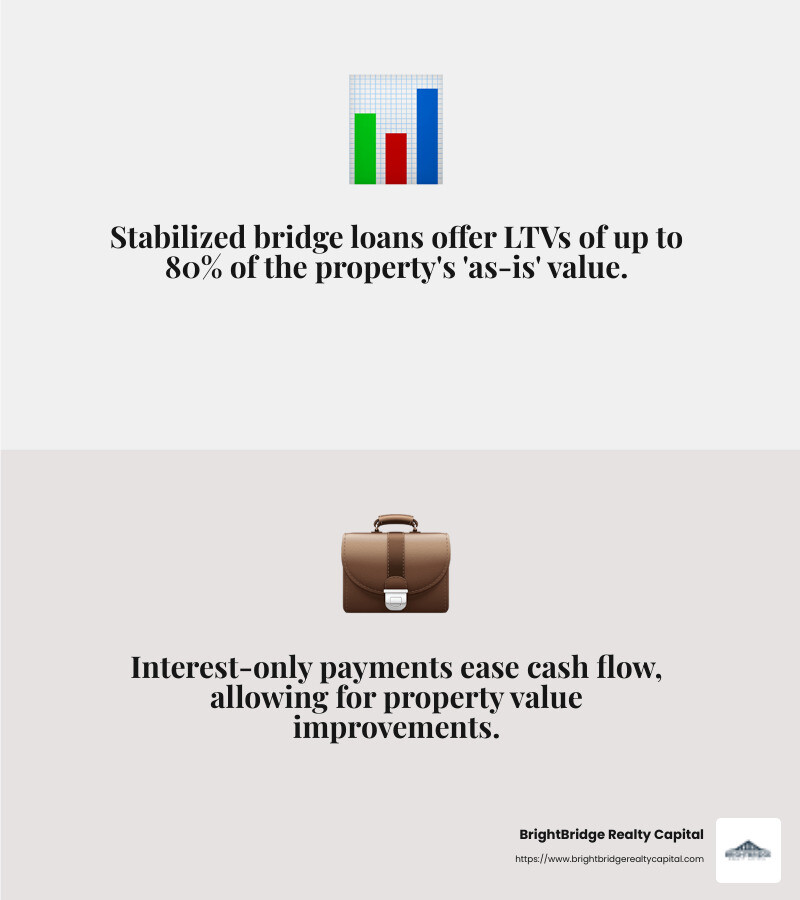Understanding Stabilized Bridge Loans: A Comprehensive Guide

Stabilized bridge loan is a vital tool for real estate investors dealing with short-term financing challenges. This type of loan serves as a bridge, providing the necessary capital to purchase or renovate properties while awaiting long-term funding. It's particularly beneficial for those looking to swiftly secure or improve real estate assets without the tedious wait often associated with traditional financing methods.
- Purpose: To provide fast, short-term capital until permanent financing is secured.
- Loan Types: Used for property purchases, renovations, or to refinance existing debt.
- Benefits: Flexibility and speed, allowing investors to quickly capitalize on market opportunities.
In a competitive market like real estate, timing is everything. A stabilized bridge loan allows investors to act swiftly, closing deals that might otherwise take weeks or months to finalize. The streamlined process of these loans can often be the difference between seizing a profitable investment opportunity and watching it slip away.

Must-know stabilized bridge loan terms:
What is a Stabilized Bridge Loan?
A stabilized bridge loan is a type of short-term financing designed to help real estate investors manage cash flow and secure properties swiftly. These loans are crucial when quick action is needed to purchase or renovate a property before obtaining permanent financing.
Short-Term Loan
Stabilized bridge loans are typically short-term, usually ranging from 12 to 36 months. They provide immediate funds, allowing investors to act quickly in competitive markets. This speed is essential when an investor needs to close a deal fast or when a property requires immediate renovation to increase its value.
Transition to Permanent Financing
The goal of a stabilized bridge loan is to "bridge" the gap between the initial purchase or renovation and securing long-term, permanent financing. Once the property is stabilized—meaning it's generating consistent income or is fully renovated—the investor can refinance into a more traditional mortgage with a lower interest rate and longer terms.
Ideal for Real Estate Investors
Real estate investors often face situations where they need to move quickly to secure a property. A stabilized bridge loan offers the flexibility and speed required to make these investments happen. Whether it's a multifamily property that needs renovation or a commercial building that requires quick acquisition, these loans provide the necessary capital without the lengthy approval processes of traditional financing.
Stabilized bridge loans are a strategic tool for investors looking to maximize opportunities in the real estate market. They offer a quick, flexible solution to secure properties and transition to more stable, long-term financing once the property is ready.

Key Features of Stabilized Bridge Loans
When considering a stabilized bridge loan, understand its key features. These features make these loans a popular choice for real estate investors who need quick and flexible funding.
Flexible Terms
One of the standout features of stabilized bridge loans is their flexibility. Borrowers can choose from various term options, typically ranging from 12 to 36 months. This flexibility allows investors to tailor the loan duration to match their project timelines, ensuring they aren't rushed into securing permanent financing before they're ready.
Interest-Only Payments
Many stabilized bridge loans offer interest-only payment options. This means that during the loan term, borrowers only pay the interest, not the principal. This structure can significantly ease cash flow, allowing investors to focus on improving the property's value without the burden of hefty monthly payments. Once the property is stabilized, they can refinance into a long-term loan to start repaying the principal.
Loan-to-Value Ratio (LTV)
The loan-to-value ratio is another critical aspect of stabilized bridge loans. These loans often offer LTVs of up to 80% of the property's "as-is" value. This high LTV allows investors to maximize the amount of financing they can secure relative to the property's current value. It's particularly beneficial for those looking to purchase properties that need renovation or stabilization, as it provides the necessary capital to fund these improvements.

In summary, the flexible terms, interest-only payment options, and favorable loan-to-value ratios make stabilized bridge loans an attractive choice for real estate investors. These features provide the necessary flexibility and financial structure to seize investment opportunities quickly and effectively.
Advantages of Stabilized Bridge Loans
When it comes to stabilized bridge loans, there are several compelling advantages that make them a go-to option for real estate investors. Let's explore these benefits:
Quick Closings
One of the most significant advantages of stabilized bridge loans is their speed. Unlike traditional financing, which can take months to close, these loans can be finalized in just a few weeks. This rapid closing process allows investors to act swiftly on promising opportunities. For example, if a lucrative property becomes available, a quick closing ensures you don't miss out due to lengthy financing delays.
Flexible Repayment
Stabilized bridge loans offer flexible repayment options that are custom to the investor's needs. You might choose interest-only payments during the loan term, which can significantly ease cash flow. This flexibility allows you to focus on property improvements or stabilization efforts without the pressure of large monthly payments. Once your property is stabilized, you can transition to permanent financing and start repaying the principal.
Market Timing
Another key advantage is the ability to capitalize on market timing. Real estate markets can change rapidly, and having access to quick financing allows investors to take advantage of favorable market conditions. Whether it's purchasing a property in a high-demand area or refinancing to leverage increased property values, stabilized bridge loans provide the agility needed to make timely decisions.
These advantages make stabilized bridge loans a powerful tool for real estate investors looking to maximize their opportunities in a dynamic market. Whether you're aiming for quick closings, flexible repayment, or strategic market timing, these loans offer the solutions you need to succeed.
How to Qualify for a Stabilized Bridge Loan
Qualifying for a stabilized bridge loan involves a few key considerations. Let's break down what lenders typically look for:
Asset-Based Lending
First and foremost, stabilized bridge loans are primarily based on the asset itself. Lenders focus on the property you're purchasing or refinancing. They evaluate its current condition and potential value after improvements. This means the property should be in a desirable location and within the market's 90th percentile in value. Lenders prefer properties that are ready to rent, whether occupied or vacant.
Borrower Experience
Your experience as a real estate investor plays a vital role in the approval process. Lenders favor borrowers who have a track record of successful real estate investments. If you've managed similar projects before, it demonstrates your capability to handle the risks and challenges associated with property investments. This experience reassures lenders that you can effectively stabilize the property and transition to permanent financing.
Credit Score
While the property is the main focus, your credit score still matters. A credit score of 620 or higher is generally preferred. A strong credit score indicates reliability and financial responsibility, which boosts lender confidence. However, even if your credit score is not perfect, your experience and the property's potential value can still make a strong case for approval.
In summary, qualifying for a stabilized bridge loan involves a combination of asset evaluation, borrower experience, and creditworthiness. By focusing on these areas, you can increase your chances of securing the financing you need to capitalize on real estate opportunities.
Next, let's address some common questions about stabilized bridge loans to further clarify this financing option.


